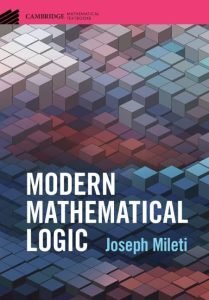Mileti, Modern Mathematical Logic, Chs 7–10
 To continue. Chapter 7 of Mileti’s MML is titled “Model theory”. Of the five sections, the first three can’t be recommended. In particular, §7.2 makes such heavy weather of that fun topic, nonstandard models of arithmetic and analysis. There are so many alternative treatments which will be more accessible and give a more intuitive sense of what’s going on. By contrast, I thought §7.4 on quantifier elimination did a better-than-often job at explaining the key ideas and working through examples. §7.5 on algebraically closed fields worked pretty well too.
To continue. Chapter 7 of Mileti’s MML is titled “Model theory”. Of the five sections, the first three can’t be recommended. In particular, §7.2 makes such heavy weather of that fun topic, nonstandard models of arithmetic and analysis. There are so many alternative treatments which will be more accessible and give a more intuitive sense of what’s going on. By contrast, I thought §7.4 on quantifier elimination did a better-than-often job at explaining the key ideas and working through examples. §7.5 on algebraically closed fields worked pretty well too.
And now we get two chapters on set theory, together amounting to almost a hundred pages. There’s a major oddity. The phrase “cumulative hierarchy” is never mentioned: nor is there any talk of sets being found at levels indexed by the ordinals. The usual V-shaped diagram of the universe with ordinals running up the spine is nowhere to be seen. I do find this very strange — and not very ‘modern’ either! There are minor oddities too. For example, the usual way of showing that the Cartesian product of  and
and  (defined as the set of Kuratowski pairs
(defined as the set of Kuratowski pairs  ) is a set according to the ZFC axioms is to use Separation to carve it out of the set
) is a set according to the ZFC axioms is to use Separation to carve it out of the set  in the obvious way. Mileti instead uses an unobvious construction using Replacement. Why? A reader might well come away from the discussion with the impression that Replacement is required to get Cartesian products and hence all the constructions of relations and functions which depend on that. (I rather suspect that Mileti isn’t much interested in ‘modern’ finer-tuned discussions of what depends on what, such as the question of which set-theoretic claims really do depend on something as strong as replacement.)
in the obvious way. Mileti instead uses an unobvious construction using Replacement. Why? A reader might well come away from the discussion with the impression that Replacement is required to get Cartesian products and hence all the constructions of relations and functions which depend on that. (I rather suspect that Mileti isn’t much interested in ‘modern’ finer-tuned discussions of what depends on what, such as the question of which set-theoretic claims really do depend on something as strong as replacement.)
So: Chapter 8, without explicitly mentioning the cumulative hierarchy (let alone the possibility of potentially more natural axiomatisations in terms of levels) gives us ZFC, and the usual sort of story about how to develop arithmetic and analysis in set theory. The mentioned oddities apart it is generally OK: but the recommendations for entry-level set theory in the Beginning Mathematical Logic Guide do the job better and in a friendlier way. However I should mention that, at the end of the chapter, §8.7 on models, sets and classes, does do the job of explaining the role of class talk rather nicely.
Chapter 9 is on ordinals, cardinals, and the axiom of choice; and I thought this chapter worked comparatively well. (Perhaps the perceived unevenness is all in my mind! And I know from my own efforts in writing long-ish books that maintaining a consistent level of approachability, of proportions of helpful less formal chat around the more formal stuff and so on, is difficult. I can only report how I am finding the book — and, as they say, your mileage may vary.)
Finally in this group, Chapter 10 is much shorter, just two sections on “Set-theoretic methods in model theory”. The first, just four pages, is on sizes of models; and then the second is an opaque and to my mind misjudged ten pages on ultraproducts.
And so it goes: as with the earlier chapters, a mixed bag.
The post Mileti, Modern Mathematical Logic, Chs 7–10 appeared first on Logic Matters.



